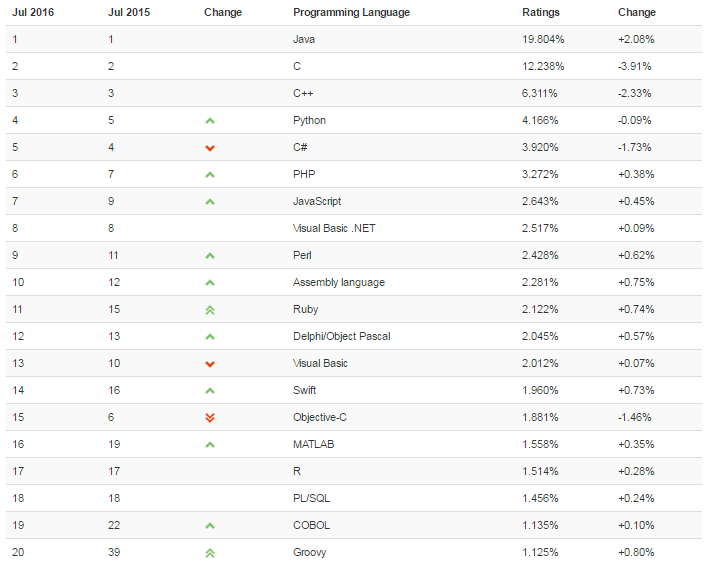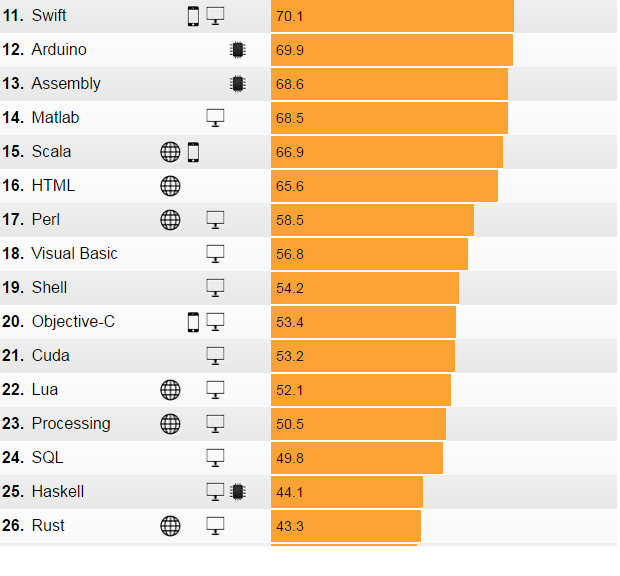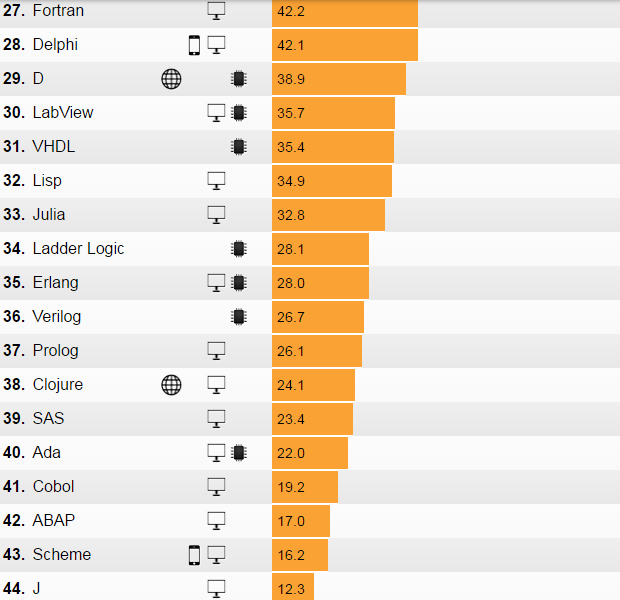The new rating of programming languages from IEEE Spectrum turned out to be original

To provide arguments in the dispute about which programming language is more popular, panelists often refer to this or that research. It is good that recently the number of such studies is growing - choose any.
But what if with the growth of various indices, lists and ratings the disputes between the researchers themselves will increase? What will they refer to in their argument?
')
IEEE Spectrum magazine presented to the public the fruit of collective work - a new rating of programming languages.
Permanent leaders of the rating did not fall from the pedestal, but still there were some surprises.
According to the publication, the researchers did not have the opportunity to "look over the shoulder of each programmer" and see what language he uses. Therefore, they went a different way: explored chat rooms, open source community, as well as job ads. The ranking also considers search results on Google, Twitter, GitHub, StackOverflow, Reddit, Hacker News, CareerBuilder, Dice. In addition, the ranking reflects the data of the own digital library of the Institute of Electrical and Electronics Engineers (Institute of Electrical and Electronics Engineers) - Xplore Digital Library.
In 2016, C became the most popular programming language of the IEEE Spectrum version: after two years of being in second place, it finally superseded Java. It is followed by Java, Python, C ++ and R. If C and Java just swapped places, then the jump of the R language to the 5th place is a surprise. As a result, a seemingly more popular language, C #, fell out of the TOP-5.

Active distribution of R is associated with the trend of big data. With the penetration of IT systems into all spheres of human activity, the volume of all kinds of data is growing exponentially: about us, our personal life, machines, companies, customers, processes, and so on. According to IDC estimates, by 2020 the global volume of digital information will increase 10-fold and reach 44 zettabyte. For storing and analyzing such amounts of data, new IT tools are created and sometimes we are not used to programming languages.
R is a universal programming language designed for use in areas such as exploratory data analysis, classical statistical tests and high-level graphics. Thanks to its extensive and continuously expanding library package, R holds a leading position in statistics and data mining. The R language has been integrated into a number of commercial packages such as IBM SPSS and InfoSphere, as well as Mathematica.
R was originally developed by Ross Aichoka (Eng. Ross Ihaka) and Robert Gentleman (the first letter of their names - R) by employees of the Statistical Faculty of Auckland University (Eng. Ross Ihaka).
R is available under the GNU GPL license.
In 2010, R entered the list of winners of the Infoworld magazine contest in the nomination for the best open source software for application development.
In fairness, we recall that the TIOBE index put this language only on the 17th position.

Python bypassed C ++ and took 3rd place. In the TIOBE index, he also rose, but by 4, shifting the long-suffering C # down a position.
The Swift programming language (from Apple) overcame five lines at once and moved to the 11th position. He first appeared in the IEEE Spectrum rating in 2015. He could go even higher, but the Go language (from Google) kept its position and closes the top 10 leaders. Although last year Go ranked 13th.

On the 12th and 13th place in the ranking are Arduino and Assembler. True, Arduino is not a programming language - it is a platform for developing electronic devices. But it shows significant growth - by as many as five positions year by year.
Shell lost many followers and immediately eight places. It has become even less popular than Perl and Visual Basic.
IEEE researchers put Visual Basic in 18th place, and TIOBE believes that it should be in 8th place.
The top 20 also includes HTML, Matlab, Scala and Objective-C. Researchers write that about interlocutors with HTML was extremely pessimistic. However, the markup language has not lost its high position.

Fortran, Delphi and D close the top 30 with dignity. Although TIOBE index put Delphi in 12th place.
IEEE Spectrum has compiled this rating for the third year in a row. This year, in the list of the most popular programming languages according to IEEE, no new (compared to last year) language has appeared.
IEEE Spectrum is a monthly magazine. Its publisher is the Institute of Electrical and Electronics Engineers. Wikipedia gives the official description of the magazine:
“The IEEE Spectrum magazine, the IEEE flagship publication, explores the development, application and implications of introducing new technologies. It anticipates trends in engineering, science and technology, and also serves as a forum for understanding, discussing and guiding in these areas. ”
The TIOBE index, unlike the IEEE Spectrum, puts Java in the first place, and C in the second place.

Let someone say that C is outdated, that its wide distribution is a result of luck and active PR. Let someone say that without UNIX, C would never have been created.
However, C has become a kind of standard. He, one way or another, passed the test of time, unlike many other languages. C-developers are still in demand, and the IT community remembers the creators of the language with a kind word.
Source: https://habr.com/ru/post/306642/
All Articles